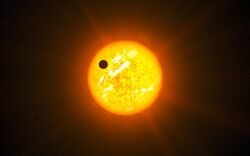Astronomy:WASP-8
| Observation data Equinox J2000.0]] (ICRS) | |
|---|---|
| Constellation | Sculptor |
| Right ascension | 23h 59m 36.07119s[1] |
| Declination | −35° 01′ 52.9236″[1] |
| Apparent magnitude (V) | 9.87[2] |
| Characteristics | |
| WASP-8A | |
| Evolutionary stage | main-sequence |
| Spectral type | G8V[3] |
| WASP-8B | |
| Spectral type | M[4] |
| Astrometry | |
| Radial velocity (Rv) | −1.38±0.26[1] km/s |
| Proper motion (μ) | RA: 109.752[1] mas/yr Dec.: 7.615[1] mas/yr |
| Parallax (π) | 11.1052 ± 0.0175[1] mas |
| Distance | 293.7 ± 0.5 ly (90.0 ± 0.1 pc) |
| Position (relative to WASP-8A)[4] | |
| Component | WASP-8B |
| Epoch of observation | 2016 |
| Angular distance | 4.520±0.005″ |
| Position angle | 170.9±0.1° |
| Observed separation (projected) | 408 AU {{{projsepref}}} |
| Details[5] | |
| WASP-8A | |
| Mass | 1.093±0.024 M☉ |
| Radius | 0.976±0.020 R☉ |
| Luminosity | 0.79 L☉ |
| Surface gravity (log g) | 4.498±0.018 cgs |
| Temperature | 5600±80 K |
| Metallicity [Fe/H] | 0.29±0.03 dex |
| Rotational velocity (v sin i) | 1.90±0.05[6] km/s |
| Age | 0.3+0.9 −0.1 Gyr |
| WASP-8B | |
| Mass | 0.53±0.02 M☉ |
| Temperature | 3758+47 −43 K |
| Other designations | |
| Database references | |
| SIMBAD | A |
| B | |
WASP-8 is a binary star system 294 light-years (90 parsecs) away. The star system is much younger than the Sun at 300 million to 1.2 billion years age, and is heavily enriched in heavy elements, having nearly twice the concentration of iron compared to the Sun.[5]
The primary, WASP-8A, is a magnitude 9.9 main-sequence yellow dwarf star. It is reported to be a G-type star with a temperature of 5600 K and has a mass 1.093±0.024, a radius 0.976±0.020 and a luminosity of 0.79 times that of the Sun. There is a companion star WASP-8B located 4.5 arcseconds away with the same proper motion, indicating a stellar binary system.[7] The binarity was confirmed in 2020.[4] The axis orientation of the primary star is uncertain, but it is close to pointing one of the poles to the Earth.[6]
Planetary system
The primary star is orbited by two known exoplanets, designated WASP-8b and WASP-8c. WASP-8b was discovered in 2010 by the astronomical transit method and was catalogued as part of the SuperWASP mission.[7] WASP-8c was discovered in late 2013 with the radial velocity method.[8]
| Companion (in order from star) |
Mass | Semimajor axis (AU) |
Orbital period (days) |
Eccentricity | Inclination | Radius |
|---|---|---|---|---|---|---|
| b | 2.216±0.035 MJ | 0.0817±0.0006 | 8.158715(16)[9] | 0.3057±0.0046[9] | 88.51±0.09° | 1.165±0.032 RJ |
| c | ≥9.45+2.26 −1.04 MJ |
5.28+0.63 −0.34 |
4323+740 −380 |
0 | — | — |
See also
- SuperWASP
References
- ↑ 1.0 1.1 1.2 1.3 1.4 Vallenari, A. et al. (2022). "Gaia Data Release 3. Summary of the content and survey properties". Astronomy & Astrophysics. doi:10.1051/0004-6361/202243940 Gaia DR3 record for this source at VizieR.
- ↑ 2.0 2.1 "WASP-8". SIMBAD. Centre de données astronomiques de Strasbourg. http://simbad.u-strasbg.fr/simbad/sim-basic?Ident=WASP-8.
- ↑ Salz, M. et al. (April 2015). "High-energy irradiation and mass loss rates of hot Jupiters in the solar neighborhood". Astronomy & Astrophysics 576: A42. doi:10.1051/0004-6361/201425243. Bibcode: 2015A&A...576A..42S.
- ↑ 4.0 4.1 4.2 Bohn, A. J.; Southworth, J.; Ginski, C.; Kenworthy, M. A.; Maxted, P. F. L.; Evans, D. F. (2020), "A multiplicity study of transiting exoplanet host stars", Astronomy & Astrophysics 635: A73, doi:10.1051/0004-6361/201937127, Bibcode: 2020A&A...635A..73B
- ↑ 5.0 5.1 5.2 Southworth, J.; Bohn, A. J.; Kenworthy, M. A.; Ginski, C.; Mancini, L. (2020), "A multiplicity study of transiting exoplanet host stars", Astronomy & Astrophysics 635: A74, doi:10.1051/0004-6361/201937334, Bibcode: 2020A&A...635A..74S
- ↑ 6.0 6.1 Bourrier, V.; Cegla, H. M. et al. (March 2017). "Refined architecture of the WASP-8 system: A cautionary tale for traditional Rossiter-McLaughlin analysis". Astronomy & Astrophysics 599: A33. doi:10.1051/0004-6361/201629973. Bibcode: 2017A&A...599A..33B.
- ↑ 7.0 7.1 Queloz, D. et al. (2010). "WASP-8b: a retrograde transiting planet in a multiple system". Astronomy and Astrophysics 517: L1. doi:10.1051/0004-6361/201014768. Bibcode: 2010A&A...517L...1Q. http://www.aanda.org/articles/aa/full_html/2010/09/aa14768-10/aa14768-10.html.
- ↑ 8.0 8.1 Knutson, Heather A.; Fulton, Benjamin J.; Montet, Benjamin T.; Kao, Melodie; Ngo, Henry; Howard, Andrew W.; Crepp, Justin R.; Hinkley, Sasha et al. (2013), "Friends of Hot Jupiters. I. A Radial Velocity Search for Massive, Long-Period Companions to Close-In Gas Giant Planets", The Astrophysical Journal 785 (2): 126, doi:10.1088/0004-637X/785/2/126, Bibcode: 2014ApJ...785..126K
- ↑ 9.0 9.1 Bonomo, A. S. et al. (June 2017). "The GAPS Programme with HARPS-N at TNG. XIV. Investigating giant planet migration history via improved eccentricity and mass determination for 231 transiting planets". Astronomy & Astrophysics 602: A107. doi:10.1051/0004-6361/201629882. Bibcode: 2017A&A...602A.107B.
External links
- WASP planets
- "Notes for star WASP-8". Extrasolar Planets Encyclopaedia. http://exoplanet.eu/star.php?st=WASP-8. Retrieved 2008-08-07.
Coordinates: ![]() 23h 59m 36.07s, −35° 01′ 52.9″
23h 59m 36.07s, −35° 01′ 52.9″
 |

